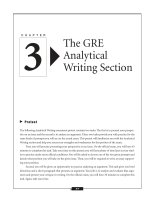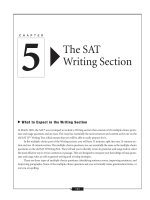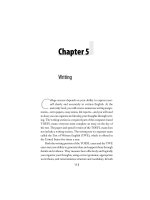Learning Express TOEFL Exam Essentials - Writing
Bạn đang xem bản rút gọn của tài liệu. Xem và tải ngay bản đầy đủ của tài liệu tại đây (114.55 KB, 26 trang )
Chapter 5
Writing
C
ollege success depends on your ability to express your-
self clearly and accurately in written English. At the
university level, you will receive numerous writing assign-
ments—term papers, essay exams, lab reports—and you will need
to show you can organize and develop your thoughts through writ-
ing. The writing section is a required part of the computer-based
TOEFL exam; everyone must complete an essay on the day of
the test. The paper-and-pencil version of the TOEFL exam does
not include a writing section. The writing test is a separate exam
called the Test of Written English (TWE), which is offered in
the United States five times a year.
Both the writing portion of the TOEFL exam and the TWE
exam test your ability to generate ideas and support them through
details and evidence. They measure how effectively and logically
you organize your thoughts, using correct grammar, appropriate
word choice, and varied sentence structure and vocabulary. In both
113
114 TOEFL EXAM ESSENTIALS
tests, you will be given 30 minutes in which to compose a short
essay (about four to five paragraphs long) about a given topic. The
topics are designed to be general so that you do not need any spe-
cialized knowledge to respond to them.
COMPUTER TEST VS. PAPER TEST
The writing section of the computer-based TOEFL exam differs
from the paper-based TWE exam. Although the types of writ-
ing prompts are the same, the TWE exam is offered separately
from the paper-based TOEFL exam and at limited times, whereas
the computer-based test requires that you write an essay on the
same day as the rest of the TOEFL exam. Both tests give you 30
minutes to respond to one pre-selected topic. The following
chart compares the two tests:
Paper-and-Pencil:
Computer Test: Test of Written English
Writing (TWE)
Mandatory part of the Separate test (not part of
computer test. the paper-and-pencil TOEFL
exam).
Offered whenever the Offered only five times a
computer test is given. year. If you need to take the
TWE exam, select a TOEFL
exam date when the TWE
exam is also offered. (There
is no additional cost.)
WRITING 115
TYPES OF WRITING PROMPTS
The computer test and the TWE exam use the same type of writ-
ing prompt—a general topic and a question about that topic. Most
prompts present a statement, situation, or scenario and ask you
to take a position and explain it. They can be broken down into
three parts:
1. a statement or situation to consider
2. a question
3. directions
Note the three parts in this example:
Essay topic randomly All test-takers respond to
selected by computer. same essay topic.
Other test-takers may
have different topics.
Essay topics posted on No published list of TWE
www.toefl.org. exam essay topics.
You may handwrite your You must handwrite your
essay or type it on the essay.
computer.
Your writing score is com- Your TWE exam essay score
bined with your score on is reported separately from
the structure section. It your TOEFL exam score.
counts as 50 percent of your
total structure/writing score.
116 TOEFL EXAM ESSENTIALS
(1) Many people feel that American society is too competitive. (2)
Do you agree or disagree? (3) Use specific reasons and examples to
support your position.
Some prompts skip the first part (statement/situation). Oth-
ers incorporate the first part within the question. Here is an
example of the latter:
(1 and 2 combined) Do you agree that “honesty is the best pol-
icy”? (3) Use specific reasons and examples to support your answer.
Although all of the writing prompts fit the basic formula
described above, they can be divided more specifically into five
types:
1. Agree or disagree. The most common prompt on the
TOEFL exam, this type asks you to agree or disagree
with a statement. Here is an example:
Test Time Saver
Decide beforehand if you are going to handwrite or type
your essay.
If you are typing it, familiarize yourself with the word-
processing software used on the TOEFL exam (you can do
this at www.toefl.org). Handwritten essays must fit on two
sides of a single page. Represent yourself in the best light
by writing legibly and neatly.
WRITING 117
Thomas Edison, the renowned inventor, once said, “Genius is
one percent inspiration, ninety-nine percent perspiration. Do
you agree or disagree with this statement? Use specific reasons
and examples to support your answer.
2. Explain your position. The second most common
prompt, this type asks you to state your position on a
general issue. Often prompts follow this pattern:
“Some people prefer x. Others y. Which do you
prefer?” Here are some examples:
Some people prefer to live in the quiet of the country; others
prefer the hustle and bustle of the city. Which do you prefer?
Use specific reasons and examples to support your answer.
Who makes a better leader: someone who is loved, or someone
who is feared? Take a position and explain your answer.
3. Describe a characteristic. This prompt asks you to
identify an important characteristic of a person, place,
or thing. Unlike the first two kinds of prompts that
narrow your responses, this type allows you to choose
the characteristic you want to discuss.
What are some of the qualities of a good teacher? Use specific
reasons and examples to support your answer.
People define “success” in different ways. In your opinion, what
one characteristic best defines success? Use specific reasons and
example to support your choice.
118 TOEFL EXAM ESSENTIALS
4. What if? This prompt presents you with an “if-then”
type of scenario: If x happened, then what would you
do? Questions may be open-ended or may limit your
choices to two possible reactions to the situation.
If you could travel anywhere in the world, what one place would
you go to? Why? Use specific reasons and examples to support
your choice.
If you could meet a famous person from any historical time
period, who would it be? Why? Use specific reasons and exam-
ples to support your choice.
5. Cause or effect. For this type of prompt, you will
consider a phenomenon and look for its causes, or you
will consider a cause and look at its effects. You do not
need expert knowledge to respond; use your common
sense and personal experiences to answer.
The Internet allows people to access information in an instant.
How has the speed of this technology changed people’s behavior?
Use specific reasons and examples to support your answer. (Dis-
cuss effect.)
Some citizens do not vote in elections. Why do you think some
people do not take advantage of their right to vote? (Discuss
cause.)
TIPS FOR THE WRITING TEST
To save time and get your best score on the writing test, follow
these guidelines:
WRITING 119
Stick to your assigned topic. You cannot choose your own
topic. If you write about a different topic, you will receive
a score of “0.”
Read questions carefully. If a prompt asks you to discuss only
one characteristic, limit yourself to one. If you write about
three characteristics, you will receive a lower score.
Limit your focus. For example, if a question asks you to
describe some of the qualities you value in a friend, quickly
choose two or three characteristics for your essay. You do
not have enough time or space to discuss more.
Impose conditions. Some questions give you only two
choices for your response, but that does not mean you are
limited to a simple “yes” or “no” answer. For example, a
prompt may ask you: “Do you agree or disagree that all stu-
dents should wear school uniforms instead of whatever
clothing they desire?” You can impose some conditions in
your answer: “Students should not have to wear school
Find Topics Online
All of the writing prompts used on the computer-based
TOEFL exam are available online. Although you cannot
select which one you want to write about on the test,
make sure to review the topics list. Pick several prompts
and practice composing essays (be sure to time yourself).
To view the topics:
1. Go to www.toefl.org.
2. Click on “Test Prep.”
3. Click on “Writing Topics.”
120 TOEFL EXAM ESSENTIALS
uniforms, but there should be restrictions about what kind
of clothing students can wear.”
ALL ABOUT SCORING
The scoring system for the computer test and the TWE exam is
the same: two readers independently rate your essay and give it
a score from 0–6. The two scores are then averaged to determine
your final essay score. For example, if one reader gives your essay
a score of 6 and the other a 5, your score will be 5.5. If there is a
discrepancy of more than one point, (e.g., one reader rates your
essay a 4, and the other a 6), a third reader will independently score
your essay.
The developers of the TOEFL exam created a scoring guide
to aid readers in rating essays. The guide names specific criteria
for each score. The official writing guide is available online at
www.toefl.org or in the exam bulletin. Review the qualities of a
top-rated essay. The more you know about what official exam read-
ers are looking for, the more likely you will meet those expecta-
tions. The following guidelines are adapted from the TOEFL
exam “Writing Score Guide.”
Your Guide to Scoring
Score An essay with this score:
6
■
fully addresses the essay topic
■
makes a clear thesis statement (main idea)
■
gives appropriate details and examples to support its
thesis
■
is organized logically and develops ideas thoroughly
WRITING 121
■
uses correct grammar and makes appropriate word
choices consistently
■
demonstrates variety in sentence structure and
vocabulary
5
■
addresses the essay topic, but responds to some parts
more effectively than others
■
makes a thesis statement
■
gives details and examples to support its thesis
■
has an overall effective organization and develops
ideas (e.g., four or five well-developed paragraphs)
■
uses correct grammar throughout most of the essay
■
demonstrates some variety in sentence structure and
vocabulary
4
■
addresses the essay topic, but does not respond to all
of its parts
■
uses some details to support a thesis
■
is organized but does not use the most effective or
logical approach
■
develops ideas adequately (e.g., four developed
paragraphs)
■
includes grammatical and usage errors that may
confuse meaning
■
demonstrates less variety in sentence structure and a
more limited vocabulary
3
■
does not have a clear thesis
■
has weak organization and development (e.g., two or
three short paragraphs)
■
offers few or irrelevant details to support its thesis
■
uses words and phrases inappropriately
■
makes several grammatical errors
122 TOEFL EXAM ESSENTIALS
2
■
lacks focus
■
gives few or no details
■
is disorganized and underdeveloped (e.g., only two
short paragraphs)
■
makes serious and frequent grammatical errors
1
■
is incoherent
■
is underdeveloped (e.g., only one paragraph)
■
makes serious and persistent grammatical errors
0
■
is blank
■
simply copies the essay topic but does not respond
to it
■
addresses another topic
■
uses a language other than English
■
consists only of a series of random keystrokes
KEEPING TIME ON THE ESSAY EXAM
You have just half an hour to write a top-rated essay. Should you
plunge right in or take time to plan your essay first? Even though
time is limited, your chances of doing well increase if you organize
your thoughts before you write. The writing process includes three
important steps: planning, writing, and proofreading. To make time
for each step, follow these guidelines during the writing test:
5–10 minutes plan (choose a thesis, brainstorm, and outline
your essay)
15–20 minutes write
5 minutes proofread (reread for errors or to adjust word
choice)
= 30 minutes









